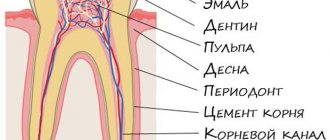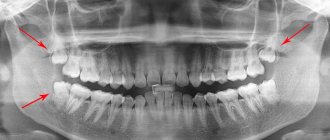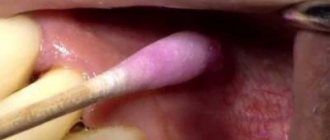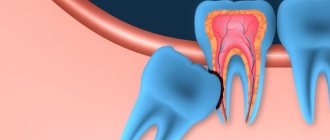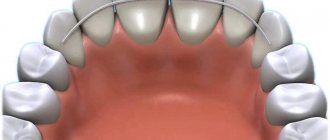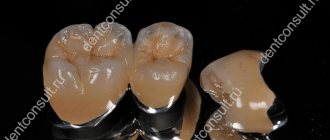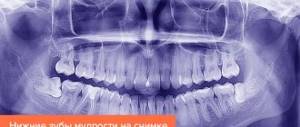Is there any point in treating wisdom teeth?
In dentistry, this issue remains relevant to this day. If earlier people had a more massive jaw, which was due to the need to chew coarse and hard food, today the jaw arch has become narrower, so the “eights” often simply do not have enough space. However, even if the third molars erupted without complications and fit normally into the dentition, this does not mean that there will be no problems with them in the future, because the risk of caries is no less than on other teeth. But despite the fact that the “eights” are least involved in the distribution of the chewing load, nature does not create anything for nothing. Each tooth has its own value, so even eighth teeth can be useful, especially as a possible support for installing a denture.
Indications for prosthetics by installing dental crowns
There are certain indications for installing a crown on a tooth, as for any other dental procedure. In what cases is prosthetics with dental crowns performed? It would be advisable to carry out the procedure in the following circumstances:
- Significant destruction of dental units by deep caries.
- Traumatic tooth destruction, in which the unit still has healthy roots.
- Aesthetic defects: noticeable discoloration of the enamel coating, chips.
Also, the installation of temporary crowns will be justified in case of periodontitis: the design will prevent further loosening of the teeth and, accordingly, will protect them from falling out. Indications for crown installation are determined during a diagnostic examination. Do you need to get a crown on your tooth? The orthopedists of our dentistry in Moscow - VENSTOM - will help you find the answer to this question! Come see a specialist at any time convenient for you. We are located next to the Baumanskaya metro station, you can walk to the clinic from the metro in just five minutes!
Difficulties in treating wisdom teeth
- Location.
Wisdom teeth are located in the most inaccessible area of the jaw, so even the simplest therapeutic manipulations are difficult to carry out. - Unexpressed symptoms.
Painful sensations appear at the advanced stage of caries, when the pulp is often already affected. - High risk of secondary caries.
Due to the difficulty of treating wisdom teeth, eights have a higher risk of secondary caries compared to other teeth. - Complex treatment of pulpitis and periodontitis.
The figure-of-eight canals are highly curved, which significantly complicates endodontic treatment.
How to remove a tooth
There are two extraction methods used in dentistry: simple and complex. Their choice depends on which teeth are being removed - premolars and molars with tangled branched roots are removed using a complex method. It is very difficult to pull out such elements entirely due to the fact that the tooth socket is penetrated by retaining ligaments and alveolar processes. Errors during the procedure or insufficient experience of the specialist lead to serious complications. Therefore, even despite the acute condition, always find out in advance where you can have a tooth removed from a good doctor with positive recommendations.
Factors complicating the operation:
- complete destruction of the coronal part;
- high fragility;
- acute inflammatory diseases;
- Unerupted or misaligned wisdom teeth.
The technology of the procedure depends on which teeth are removed. In some cases, tissue incision and suturing are performed.
Whether it is painful to remove a tooth or not depends largely on the condition of the element. Anesthesia is performed in all cases, with the exception of severe allergic reactions to all types of painkillers. With the development of extensive purulent lesions, the effect of the drug may be reduced.
How long it takes to remove a tooth depends on the complexity of the operation. On average, this takes no more than 5-10 minutes (including waiting for the anesthesia to take effect). In general, the procedure includes the following steps:
- anesthesia;
- if necessary, an incision is made into the mucous membrane to access the cervical area, or the doctor lowers the gum with an instrument;
- Use forceps to fix the tooth at the lowest point without excessive pressure;
- rocking and extraction from the hole is performed;
- returning the gum flap to its place.
If inflammatory processes are diagnosed in the oral cavity, a course of antibiotics is prescribed. In some cases, extraction is performed under general anesthesia.
In case of multiple lesions, the doctor determines how many teeth can be removed in your case during one visit, but more often it is 1–2 elements. This is because extraction is a traumatic operation that will take time to recover from. Too large areas of damage increase the likelihood of complications several times and take much longer to heal.
If after surgery the extracted tooth, or rather the hole left after it, hurts, this is a reason to consult a doctor. After the procedure, minor pain is allowed during the first 24 hours. Visit the dentist if your temperature rises, swelling increases, bleeding occurs, or pain spreads to the lymph nodes. These are symptoms of a wound infection. Untimely treatment can lead to alveolitis.
Types of wisdom teeth diseases
| Disease | Treatment |
| Initial caries | In the initial stages, treatment is possible without the use of a drill (Icon method). |
| Average caries | Treatment of wisdom tooth caries at an advanced stage occurs according to the classical scheme using a drill. In case of deep damage to dentin, it is necessary to apply a therapeutic and insulating pad. |
| Pulpitis | Effective treatment of wisdom tooth pulpitis is possible with the use of modern equipment (at least an apex locator). Ideally, root canal treatment should be performed using a dental microscope. |
| Inflammation of the wisdom tooth (Treatment of inflammation of the gums around the wisdom tooth - pericoronitis) | Treatment of a hood over a wisdom tooth is carried out in several ways. - Cutting of the hood. A deep incision of the gum tissue followed by treatment of the inflamed tissue with antiseptic drugs. – Removal of wisdom tooth hood. Excision of soft tissue around the impacted figure eight |
| Wisdom tooth removal | Wisdom tooth removal is necessary in the following cases: – The presence of retention and/or dystopia with complications (complex pericoronitis, abscess, phlegmon, etc.). – Extensive carious lesions. – Absence of an antagonist tooth (relative indication for removal). |
Removing dental crowns: indications and features of the process
Removing dental crowns is a procedure that becomes necessary if certain complications arise after installing the prosthesis. Removal of the structure may be required in situations:
1. Poor quality preparation for dental crown prosthetics. If the tooth canals are poorly cleaned and poorly sealed, then an inflammatory process may begin to actively develop in them. If such a process occurs, the crown will need to be removed and the tooth treated or removed.
2. Inaccuracies in the manufacture of a crown on a tooth, in which the installed structure will overestimate the bite and not fit tightly to the tooth.
Crowns are also removed for planned replacement. High-quality structures can last up to 10 years or more, but after that the crown will be replaced with a new orthopedic product. Crown removal may be uncomfortable for the patient, so it is usually performed using local anesthesia. To remove the structure, it is sawed with a bur, removed, and those medical manipulations that are necessary for a particular case are performed.
We hope the material helped you learn all the important nuances of installing crowns on your teeth, and you can always get more detailed advice on prosthetics from the dentist at our Vanstom clinic in Moscow! To make an appointment, just call us!
Recommendations after wisdom tooth treatment
Compared to other teeth, treatment of “eight” teeth is the least predictable. To minimize the risk of new problems, the patient must follow a number of recommendations.
Care after wisdom tooth treatment
- After treatment of wisdom tooth caries, it is necessary to attend preventive visits at least once every six months. “Eights” are leaders in the number of cases of secondary caries. If your wisdom tooth hurts after treatment for a long time (more than 3-4 days), you should contact your dentist as soon as possible.
- Pain after treatment of a wisdom tooth with pericoronitis also occurs. It is necessary to follow the medications prescribed by the doctor during the rehabilitation process (antibiotics, anti-inflammatory gels and ointments).
- The longest rehabilitation is necessary after the removal of a wisdom tooth (on average, the healing process takes two weeks). During this period, it is necessary not only to take prescribed medications, but also to limit yourself in the choice of food, physical activity, alcohol and tobacco.
The main stages of the procedure for installing a dental crown
Installing a crown on a tooth - this procedure is usually divided into several stages, which will be useful to get to know before your initial visit to the dentist. The main stages of the process of placing dental crowns will be discussed in detail below.
First visit to an orthopedic dentist
During the initial appointment, the specialist examines the patient’s oral cavity, prescribing additional tests if necessary. Based on the data obtained, the doctor develops a treatment plan, offering the patient possible options for restoring lost teeth or dentition aesthetics. The treatment plan takes into account not only the need to install a denture, but also additional manipulations, including: Removal of severely damaged and non-viable dental units;
Treatment of the patient’s dental and oral diseases: caries, pulpitis, root canal filling, oral sanitation.
Next, a specific type of dental crown is selected and the cost of turnkey prosthetics is calculated and the timing of its implementation is also determined.
Treatment of wisdom teeth at home
Full treatment of wisdom teeth takes place only in the dentist’s office, and this applies to all the diseases described above. Under no circumstances should you expect pain and inflammation to go away on their own, or take various medications without the knowledge of your doctor. Negligence can lead to the most unpleasant consequences and even death. If pericoronitis is detected in the initial stage, the doctor may suggest a conservative rehabilitation method (which happens extremely rarely), but even in this case, treatment of inflammation of the wisdom tooth at home should be carried out under the supervision of a specialist.
Grinding teeth for crown installation
The professional name for the process of grinding teeth for installation of crowns is preparation, which is performed with a special device - a drill. Using diamond burs, the doctor gives the dental units the shape that will allow the crown to be firmly installed. Grinding can be a rather painful procedure for the patient if dental units that are not previously depulped are subjected to treatment. In this case, local anesthesia is required.
Natural tooth tissue is removed by a specialist to the thickness that the crown will have. On average, up to 2.5 millimeters of dentin can be removed from each side of the unit, depending on the type of crown prosthesis. Cast crowns require minimal grinding of teeth; maximum layers of tissue are removed before installing ceramic and metal-ceramic products. After grinding, a stump base remains from the tooth, on which the prosthetist will subsequently install a crown.
How much does it cost to cure a wisdom tooth?
In Moscow dentistry, the price of wisdom tooth treatment depends on the specific disease and the chosen treatment method. It is believed that treatment of lower wisdom teeth is more expensive, but this is only partly true. Removing the lower “eights” can actually cost a lot of money, since the bone tissue in the lower jaw is denser, so it becomes more difficult to remove an impacted tooth.
| Treatment of wisdom teeth | Price |
| Treatment of simple caries | from 2,500 rubles |
| Treatment of complex caries | from 4,000 rubles |
| Treatment of pulpitis | from 6,000 rubles (depending on the number of channels) |
| Easy removal | from 2,000 rubles |
| Difficult removal | from 6,000 to 12,000 rubles |
Taking impressions and making crowns
An impression is taken of the prepared dental units. For this procedure, a special dental plastic mass is used. An impression is necessary to make an exact plaster copy of the patient’s teeth, which will be used to create a permanent structure. For the production of crowns, different types of materials can be used - metal, metal-ceramics or ceramics. The specific type of raw material is selected based on the characteristics of the case and the wishes of the patient.
The production time for dental crowns depends on the type of material chosen. The production process of ceramic and metal-ceramic products takes the longest. If structures made from these materials are chosen for prosthetics, then temporary dental crowns made of plastic are made for the patient during the period of their manufacture. Temporary crowns will help to recreate the aesthetics of the dentition and, in addition, will protect the ground and weakened teeth from the destructive effects of external factors.
